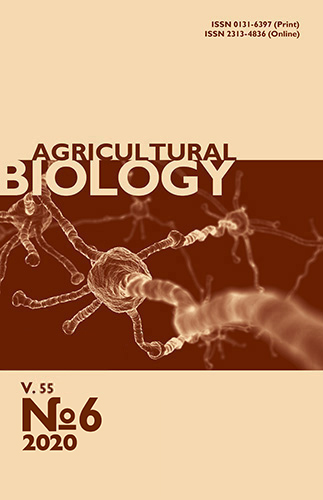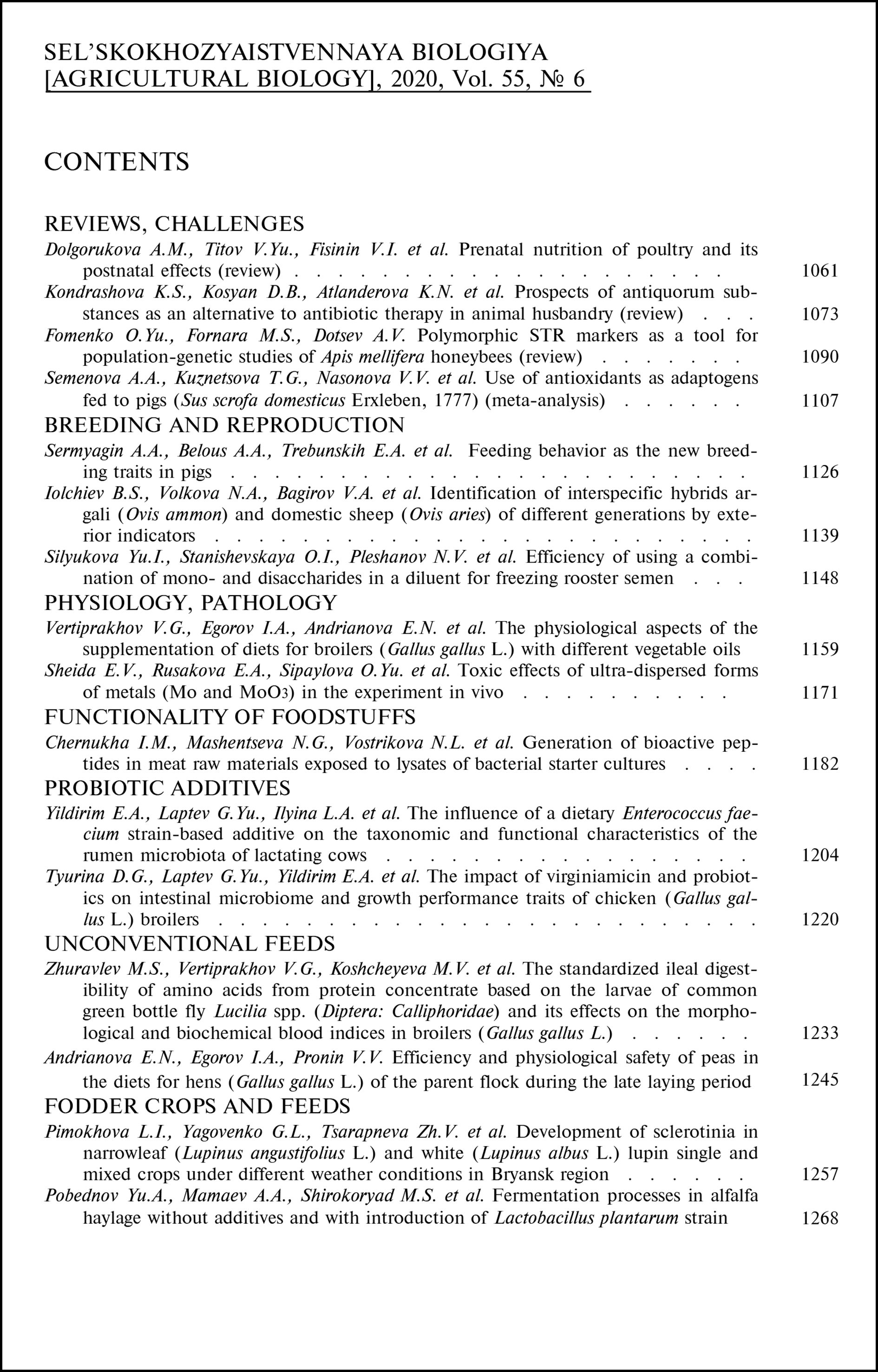doi: 10.15389/agrobiology.2020.6.1233eng
UDC: 636.087.6:636.52/.58:591.11
Acknowledgements:
Supported financially from the Russian Science Foundation for the Project No. 16-16-04089-П “Study of physiological and microbiological aspects of digestion in meat chicken in embryonic and post-embryonic periods to develop diets which fully meet the genetic potential of poultry”
THE STANDARDIZED ILEAL DIGESTIBILITY OF AMINO ACIDS FROM PROTEIN CONCENTRATE BASED ON THE LARVAE OF COMMON GREEN BOTTLE FLY Lucilia spp. (Diptera: Сalliphoridae) AND ITS EFFECTS ON THE MORPHOLOGICAL AND BIOCHEMICAL BLOOD INDICES IN BROILERS (Gallus gallus L.)
M.S. Zhuravlev1 ✉, V.G. Vertiprakhov2 ✉, M.V. Koshcheyeva2, N.P. Buryakov1, M.I. Smahliuk3, A.I. Istomin3
1Timiryazev Russian State Agrarian University—Moscow Agrarian Academy, 49, ul. Timiryazevskaya, Moscow, 127550 Russia, e-mail mikhail.sterh@gmail.com (✉ corresponding author), kormlenieskota@gmail.com;
2Federal Scientific Center All-Russian Research and Technological Poultry Institute RAS, 10, ul. Ptitsegradskaya, Sergiev Posad, Moscow Province, 141311 Russia, e-mail Vertiprakhov63@mail.ru (✉ corresponding author), lkhasanova@mail.ru, vlk.733@mail.ru;
3ООО «Zooprotein», 64 of. 701, Sovetskaya ul., Lipetsk, Lipetsk Province, 398001 Russia, e-mail ms@misma.pro,
ais@misma.pro
ORCID:
Zhuravlev M.S. orcid.org/0000-0002-4586-2937
Buryakov N.P. orcid.org/0000-0002-6776-0835
Vertiprakhov V.G. orcid.org/0000-0002-3240-7636
Smahliuk M.I. orcid.org/0000-0003-3676-9746
Koshcheyeva M.V. orcid.org/0000-0002-0744-1883
Istomin A.I. orcid.org/0000-0003-0394-5280
Received September 24, 2020
Bioconversion is an ecologically friendly and effective way of the utilization of organic wastes; it involves the use of these wastes as a substrate in the biotechnologies of different products. The larvae of the black soldier fly (Hermeia illucens L.) grown on the organic wastes have been earlier studied as a raw material for feed ingredients for poultry; recently the larvae of common green bottle fly (Lucilia spp.) draw the attention as a potential source of feed-grade protein for animals and poultry. The dried defatted biomass of the larvae contains crude protein (no less than 62 %), fat (10 %), lysine (no less than 4 %), methionine + cystine (2.0 %) and hence could be a promising protein source in diets for poultry. However, despite the apparent advantages of the bioconversion of organic wastes by insects into the dietary protein sources for poultry there is a scarcity of the data on the quality of these products and on their effects on poultry. Earlier research evidenced the efficiency of the supplementation of diets for growing turkeys with 5.0-7.5 % of dried full-fat Lucilia larvae; however, the ileal digestibility of amino acids in turkeys (necessary for the balancing of dietary amino acids) was not assessed. The study presented is a first attempt of the in vivo assessment of ileal digestibility of amino acids from Lucilia larvae protein concentrate (LLPC) in broilers (Gallus gallus L.). The aim of the study was the determination of apparent (AID) and standardized ileal digestibility (SID) of amino acids from LLPC within the experimental diet and its effects on the morphological and biochemical blood indices in broilers. AID and SID were determined in the vivarium of the All-Russian Research and Technological Institute of Poultry in 2019 on broilers (cross Smena 8, 18-42 days of age) with chronic ileal fistulae fed mono-protein diet contained LLPC, dextrose, fiber, and a premix of vitamins and minerals. SID was calculated with the endogenous losses of amino acids taken into account. SID of potentially limiting amino acids were as follows: lysine 82.9 %, methionine 86.6 %; threonine 80.4 %; arginine 89.5 %; isoleucine 80.0 %; leucine 81.9 %; valine 79.9 %; histidine 82.9 %, and phenylalanine 85.7 %. The beneficial effects of LLPC on the blood indices were found: the activity of alanine transaminase was significantly higher by 23.5 % in broilers fed LLPC in compare to control while the activity of aspartate transaminase was lower by 24.6 % (p < 0.05) indicating the prevalence of the anabolic processes over the catabolic. The significant increase in total protein concentration in serum (by 20.0 %, p < 0.05) and increase in hemoglobin concentration by 4.2 % in compare to control evidenced the activation of the metabolism. The use of SID (instead of AID) allows for more accurate balancing of dietary contents of available amino acids, more adequate amino acid supply to poultry, and for the reduction of nitrogen emissions into the environment due to the optimization of dietary protein content.
Keywords: broilers, poultry farming, alternative protein sources, ileal digestibility, insects, zooprotein.
REFERENCES
- Dedyaeva V.V., Istomin A.I., Argunov M.N., Zhukov I.V., Stepanov V.A. Materialy mezhdunarodnoi nauchno-prakticheskoi konferentsii, posvyashchennoi 90-letiyu fakul'teta veterinarnoi meditsiny i tekhnologii zhivotnovodstva, provodimoi na baze FGBOU VO Voronezhskii gosudarstvennyi agronomicheskii universitet [Proc. Int. Conf., dedicated to the 90th anniversary of the Faculty of Veterinary Medicine and Animal Husbandry Technology, the Voronezh State Agronomic University]. Voronezh, 2016: 87-90 (in Russ.).
- Nekrasov R.V., Chabaev M.G., Zelenchenkova A.A.,Bastrakov A.I., Ushakova N.A. Nutritional properties of Hermetia illucens L., a new feed product for young pigs (Sus scrofa domesticus Erxleben). Agriculktural Biology [Sel'skokhozyaistvennaya biologiya], 2019, 54(2): 316-325 CrossRef
- Bastrakov A.I., Dontsov A.E., Ushakova N.A. Izvestiya Ufimskogo nauchnogo tsentra RAN, 2016, 4: 77-79 (in Russ.).
- Oonincx D.G., Van Itterbeeck J., Heetkamp M.J., Van Den Brand H., Van Loon J.J., Van Huis A. An exploration on greenhouse gas and ammonia production by insect species suitable for animal or human consumption. PLoS ONE, 2010, 5(12): e14445 CrossRef
- Oonincx D.G.A.B., De Boer I.J.M. Environmental impact of the production of mealworms as a protein source for humans — a life cycle assessment. PLoS ONE, 2012, 7(12): e51145 CrossRef
- Van Huis A. Potential of insects as food and feed in assuring food security. Annual Review of Entomology, 2013, 58: 563-583 CrossRef
- FAO. Global food losses and food waste — extent, causes and prevention. Rome, 2011.
- Barragan-Fonseca K.B., Dicke M., van Loon J.J. Nutritional value of the black soldier fly (Hermetia illucens L.) and its suitability as animal feed — a review. Journal of Insects as Food and Feed, 2017, 3(2): 105-120 CrossRef
- Dabbou S., Gai F., Biasato I., Capucchio M.T., Biasibetti E., Dezzutto D., Schiavone A. Black soldier fly defatted meal as a dietary protein source for broiler chickens: effects on growth performance, blood traits, gut morphology and histological features. Journal of Animal Science and Biotechnology, 2018, 9(1): 49 CrossRef
- Maurer V., Holinger M., Amsler Z., Früh, B., Wohlfahrt J., Stamer A., Leiber F. Replacement of soybean cake by Hermetia illucens meal in diets for layers. Journal of Insects as Food and Feed, 2016, 2(2): 83-90 CrossRef
- Woods M.J., Cullere M., Van Emmenes L., Vincenzi S., Pieterse E., Hoffman L.C., Zotte A.D. Hermetia illucens larvae reared on different substrates in broiler quail diets: effect on apparent digestibility, feed-choice and growth performance. Journal of Insects as Food and Feed, 2019, 5(2): 89-98 CrossRef
- Veldkamp T., Van Niekerk T. Live black soldier fly larvae (Hermetia illucens) for turkey poults. Journal of Insects as Food and Feed, 2019, 5(4): 301-311 CrossRef
- Newton G.L., Booram C.V., Barker R.W., Hale O.M. Dried Hermetia illucens larvae meal as a supplement for swine. Journal of Animal Science, 1977, 44(3): 395-400 CrossRef
- Caimi C., Renna M., Lussiana C., Bonaldo A., Gariglio M., Meneguz M., Dabbou S., Schiavone A., Gai F., ConcettaElia A., Prearo M., Gasco L. First insights on Black Soldier Fly (Hermetia illucens L.) larvae meal dietary administration in Siberian sturgeon (Acipenser baerii Brandt) juveniles. Aquaculture, 2020, 515: 734539 CrossRef
- Belghit I., Liland N.S., Gjesdal P., Biancarosa I., Menchetti E., Li Y., Lock E.J. Black soldier fly larvae meal can replace fish meal in diets of sea-water phase Atlantic salmon (Salmo salar). Aquaculture, 2019, 503: 609-619 CrossRef
- Huis A., Oonincx D. The environmental sustainability of insects as food and feed. A review. Agronomy for Sustainable Development, 2017, 37(5): 43 CrossRef
- Moula N., Detilleux J. A meta-analysis of the effects of insects in feed on poultry growth performances. Animals, 2019, 9(5): 201 CrossRef
- Sogari G., Amato M., Biasato I., Chiesa S., Gasco L. The potential role of insects as feed: a multi-perspective review. Animals, 2019, 9(4): 119 CrossRef
- Romanenko E., Istomin A., Zhukov I., Argunov M., Dedyaeva V. Kombikorma, 2018, 7: 79-81 (in Russ.).
- Nekrasov R., Chabaev M., Zelenchenkova A., Zhuravlev M. Kombikorma, 2019, 3: 41-43 CrossRef (in Russ.).
- Romanenko E.A., Istomin A.I. Intensivnost' rosta i razvitiya indyushat krossa big-6 pri ispol'zovanii belka iz lichinok mukh populyatsii Lucilia caesar. Politematicheskii setevoi elektronnyi nauchnyi zhurnal Kubanskogo gosudarstvennogo agrarnogo universiteta, 2020, 157: 136-144 CrossRef (in Russ.).
- Dalibard P., Paillard E. Use of the digestible amino acid concept in formulating diets for poultry. Animal Feed Science and Technology, 1995, 53(2): 189-204 CrossRef
- Yapontsev A.E. Ptitsevodstvo, 2016, 2: 35-37 (in Russ.).
- Evropeiskaya konventsiya o zashchite pozvonochnykh zhivotnykh, ispol'zuemykh dlya eksperimentov ili v inykh nauchnykh tselyakh (ETS № 123) (Strasburg 18.03.1986) [The European Convention for the protection of vertebrate animals used for experimental and other scientific purposes (ETS № 123) (Strasburg 18.03.1986)]. Available: http://www.conventions.ru/view_base.php?id=19432. No date (in Russ.).
- Vertiprakhov V.G., Grozina A.A., Kislova I.V., Rebrakova T.M. Mezhdunarodnyi vestnik veterinarii, 2019, 4: 125-131 (in Russ.).
- Vertiprakhov V.G., Grozina A.A. Veterinariya, 2018, 12: 51-54 CrossRef (in Russ.).
- Golian A., Guenter W., Hoehler D., Jahanian H., Nyachoti C. Comparison of various methods for endogenous ileal amino acid flow determination in broiler chickens. Poultry Science, 2008, 87(4): 706-712 CrossRef
- Janssen R.H., Vincken J. P., van den Broek L.A., Fogliano V., Lakemond C.M. Nitrogen-to-protein conversion factors for three edible insects: Tenebrio molitor, Alphitobius diaperinus, and Hermetia illucens. Journal of Agricultural and Food Chemistry, 2017, 65(11): 2275-2278 CrossRef
- Hall H.N., Masey O’Neill H.V., Scholey D., Burton E., Dickinson M., Fitches E.C. Amino acid digestibility of larval meal (Musca domestica) for broiler chickens. Poultry Science, 2018, 97(4): 1290-1297 CrossRef
- Megido R.C., Poelaert C., Ernens M., Liotta M., Blecker C., Danthine S., Francis, F. Effect of household cooking techniques on the microbiological load and the nutritional quality of mealworms (Tenebrio molitor L. 1758). Food Research International, 2018, 106: 503-508 CrossRef
- Poelaert C., Beckers Y., Despret X., Portetelle D., Francis F., Bindelle J. In vitro evaluation of fermentation characteristics of two types of insects as potential novel protein feeds for pigs. Journal of Animal Science, 2016, 94: 198-201 CrossRef
- Bax M., Aubry L., Ferreira C., Daudin J., Gatellier P., Rémond D., Santé-Lhoutellier V. Cooking temperature is a key determinant of in vitro meat protein digestion rate: investigation of underlying mechanisms. Journal of Agricultural and Food Chemistry, 2012, 60(10): 2569-2576 CrossRef
- De Marco M., Martínez S., Hernandez F., Madrid J., Gai F., Rotolo L., Kovitvadhi A. Nutritional value of two insect larval meals (Tenebrio molitor and Hermetia illucens) for broiler chickens: apparent nutrient digestibility, apparent ileal amino acid digestibility and apparent metabolizable energy. Animal Feed Science and Technology, 2015, 209: 211-218 CrossRef
- Mwaniki Z., Neijat M., Kiarie E. Egg production and quality responses of adding up to 7.5 % defatted black soldier fly larvae meal in a corn-soybean meal diet fed to Shaver White Leghorns from wk 19 to 27 of age. Poultry Science, 2018, 97(8): 2829-2835 CrossRef
- Schiavone A., De Marco M., Martínez S., Dabbou S., Renna M., Madrid J., Gasco L. Nutritional value of a partially defatted and a highly defatted black soldier fly larvae (Hermetia illucens L.) meal for broiler chickens: apparent nutrient digestibility, apparent metabolizable energy and apparent ileal amino acid digestibility. Journal of Animal Science and Biotechnology, 2017, 8(1): 51 CrossRef












